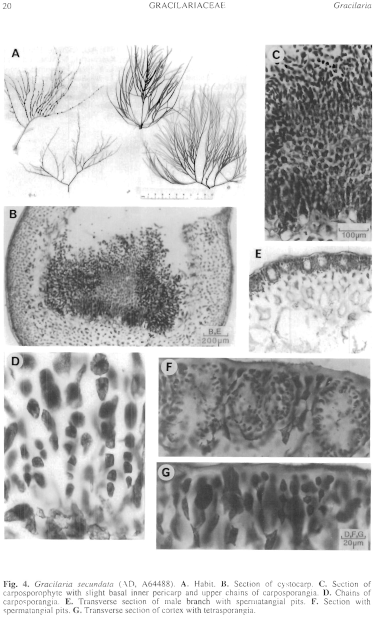|
|
|
|
|
|||||||||||
|
Electronic Flora of South Australia Species Fact Sheet
Phylum Rhodophyta – Class Florideophyceae – Order Gracilariales – Family Gracilariaceae
Selected citations: J. Agardh 1876: 418; 1901: 72. Chapman 1929: 297, pl. 104. De Toni 1900b: 440. May 1948: 46, fig. 8, pl. 11; 1965: 393. Millar & Kraft 1993: 28. Nelson 1987: 88, figs 1–5. Withell et al. 1994: 293, 348.
Thallus (Fig. 4A) medium to dark red, upper branches often fading to yellow in high light situations, cartilaginous, loosely to densely tufted, 10–30 (–50) cm high, with few to numerous secundly and irregularly branched axes of variable length. Branches terete, secund branches basally slightly constricted, larger branches not or slightly constricted, 1.5–2 mm in diameter below, lesser branchlets 0.4–0.8 mm in diameter, apices rounded-conical. Holdfast discoid, relatively thin, 2–6 (–10) mm across, with one to several axes. Structure pseudoparenchymatous, grading evenly (Fig. 4G) in cell size from the outer cortex to the medulla, cortex 3–5 cells thick with 2–3 small, ovoid, outer cells 5–6 (–8) µm in diameter and L/D (1.5–) 2–3 (–6), with frequent ovoid hair basal cells 10–20 µm in diameter; medulla 5–10 (–15) cells across, cells ovoid and 150–350 µm in diameter with numerous prominent secondary pit-connections; walls of inner cells 15–25 (–40) µm thick. Rhodoplasts discoid to laminate.
Reproduction: Gametangial thalli dioecious. Carpogonial branches not observed. Carposporophytes (Fig. 4B, C) with a small basal fusion cell, a dense pseudo-parenchymatous mass (sometimes lobed) of gonimoblast filaments (lower cells elongate-ovoid and 40–90 µm in diameter, upper cells elongate and 10–15 µm in diameter) bearing a sharply defined outer zone of chains (Fig. 4D) of ovoid to clavate carposporangia 10–18 µm in diameter; traversing nutritive cells slender, occasional to frequent. Cystocarps prominent, scattered along branches and often clustered, sessile, hemispherical or slightly to distinctly basally constricted, 1–3 mm in diameter; pericarp 200–300 µm thick, with anticlinal rows of 8–15 (–20) cells, inner cells stellate, ostiolate; inner pericarp absent to slight. Spermatangia (Fig. 4E, F) in subspherical to ovoid pits 16–25 µm in diameter, cut off from lining cells, ovoid and 3–4 µm in diameter.
Tetrasporangia (Fig. 4G) scattered in the slightly thickened cortex, basally pit-connected to inner cortical cells, ovoid, 35–90 µm long and 20–50 µm in diameter, decussately divided.
Type from Kiama, N.S.W. (Harvey); holotype in Herb. Harvey, TCD. Syntypes (from Newcastle, N.S.W.) in Alg. Aust. Exsicc. 325.
Selected specimens: Bales Beach, S coast Kangaroo I., S. Aust., in uppermost sublittoral sandy inshore pools (Womersley, 25.x.1995; AD, A64488). B.P. Refinery Pier, Westernport Bay, Vic., 1 m deep (Millar, 22.iii.1979; MELU, 23879). Ninepin Point, Tas., 10–13 m deep (Sanderson & Kraft, 22.xii.1992; MELU, 40687). Coalcliff, N.S.W., at low tide level (Harada, 28.xi.1976; AD, A52464). N. Bondi, N.S.W., upper sublittoral and pools (Womersley, 27.xii.1962; AD, A26368). Tamarama, N.S.W., upper sublittoral (Madgwick, April 1969; AD, A35086).
Distribution: Bales Beach, Kangaroo I., S. Aust., to SE Tasmania and Newcastle, N.S.W.
Taxonomic notes: Harvey (1863, synop.: xxxv) originally recorded G. secundata only from Kiama, N.S.W. Most of his Alg. Aust. Exsicc. 325 sheets however appear to be from Newcastle, north of Sydney. May (1948, p. 46) recorded her failure to locate this species at Kiama, though finding it at Newcastle.
G. secundata appears to be of sporadic occurrence on southern Australian coasts, though common at Bales Beach, Kangaroo I., in October 1995, where plants in the field were readily distinguishable from typical G. ramulosa. The former is a robust species with frequent strongly secund branches on each plant. It is, however, closely related to G. ramulosa, which in some plants does have occasional secund branches. These species differ in habit (G. ramulosa having branches of even height), in thickness of main branches (G. secundata usually broader), in size of inner medullary cells, in apparent lack of secondary cortex in G. secundata, and in the carposporophyte becoming deeply lobed in G. ramulosa. Further study of authentic G. secundata from the N.S.W. coast is, however, clearly needed since N.S.W. specimens are more robust than those from southern Australia.
References:
AGARDH, J.G. (1876). Species Genera et Ordines Algarum. Vol. 3, Part 1 — Epicrisis systematis Floridearum, pp. i-vii, 1–724. (Weigel: Leipzig.)
AGARDH, J.G. (1901). Species Genera et Ordines Algarum. Vol. 3, Part 4, pp. 1–149. (Gleerup: Lund.)
DE TONI, G.B. (1900b). Sylloge Algarum omnium hucusque Cognitarum. Vol. 4. Florideae. Sect. 2, pp. 387–776. (Padua.)
HARVEY, W.H. (1863). Phycologia Australica. Vol. 5, Plates 241–300, synop., pp. i-lxxiii. (Reeve: London.)
MAY, V. (1948). The algal genus Gracilaria in Australia. C.S.I.R.O. Bull. 235. pp. 1–64, Plates 1–15.
MAY, V. (1965). A census and key to the species of Rhodophyceae (red algae) recorded from Australia. Contr. N.S.W. natn. Herb. 3, 349–429.
MILLAR, A.J.K. & KRAFT, G.T. (1993). Catalogue of Marine and Freshwater Red Algae (Rhodophyta) of New South Wales, including Lord Howe Island, South-western Pacific. Aust. Syst. Bot. 6, 1–90.
NELSON, W.A. (1987). The New Zealand species of Gracilaria Greville (Rhodophyta, Gigartinales). N.Z. J. Bot. 25, 87–98.
WITHELL, A.F., MILLAR, A.J.K. & KRAFT, G.T. (1994). Taxonomic studies of Gracilaria (Gracilariales, Rhodophyta) from Australia. Aust. Syst. Bot. 7, 281–352.
The Marine Benthic Flora of Southern Australia Part IIIB complete list of references.
Publication:
Womersley, H.B.S. (28 June, 1996)
The Marine Benthic Flora of Southern Australia
Rhodophyta. Part IIIB. Gracilarialse, Rhodymeniales, Corallinales and Bonnemaisoniales
Reproduced with permission from The Marine Benthic Flora of Southern Australia Part IIIB 1996, by H.B.S. Womersley. Australian Biological Resources Study, Canberra. Copyright Commonwealth of Australia.
Illustration in Womersley Part IIIA, 1996: FIG. 4.

Figure 4 enlarge
Fig. 4. Gracilaria secundata (AD, A64488). A. Habit. B. Section of cystocarp. C. Section of carposporophyte with slight basal inner pericarp and upper chains of carposporangia. D. Chains of carposporangia. E. Transverse section of male branch with spermatangial pits, F. Section with spermatangial pits. G. Transverse section of cortex with tetrasporangia.

|
Email Contact: State Herbarium of South Australia |

|